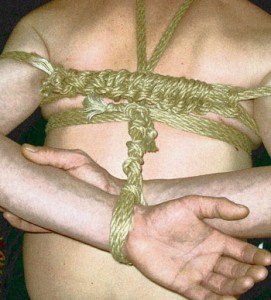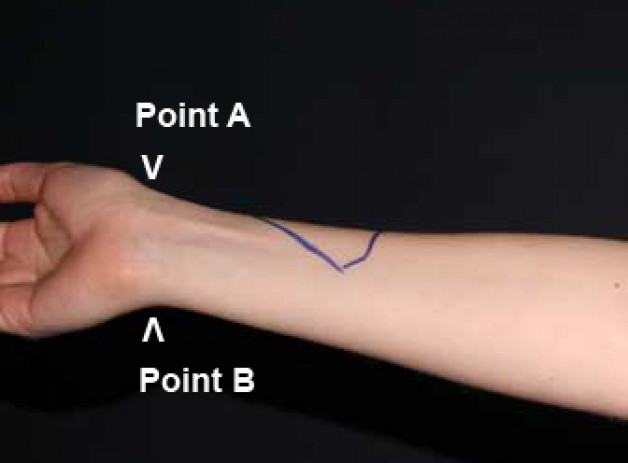I recently ran intermediate and advanced courses in which I taught the standard OS TK (actually more correctly called a ‘gote or ‘gote shibari as it does not exhibit the typical ‘high hand’ position) and revised the tie with those who professed to know it. Almost all of those who already had a good idea of how to complete the steps, and many of those who were taught from scratch, were leaving insufficient safety space at the wrists. In the main, I believe this is because force of habit makes people treat it like any other single column tie where being able to slide a finger or two under the binding is sufficient slack. The wrist tie here is a special case since it is not designed to restrain but merely to support the forearms in a parallel position, create the stem and retain the original shape of the tie. The idea is to prevent the arms dropping into and X-shape, which destroys the shape and tends to tighten the wrist tie. In the example shown below, the wrists are in the ‘facing backwards’ position that seems to be common in Japan. Whilst they have dropped and tightened the binding, it is still well away from the danger points.

There is no need to make this tight as the two torso/arm wraps do this job by preventing the arms being moved outwards and the wrists being withdrawn from the binding. Thus, around double the safety space would be my recommendation. The benefit of the additional safety space is twofold.
Firstly, it helps to prevent excessive pressure on the binding due to the loading of the harness during suspension. As the load is placed on the main line, the wraps will move away from the body thus adding tension on the main stem, which obviously begins at the wrists. Thus, the wrists will be drawn upwards out of parallel into more into an ‘X’ so increasing the pressure on the lower and upper sides of the wrists. This effect will be greater with lower wrap tension since the bindings will be allowed to move further from the body creating what Osada Steve refers to as ‘melon space’, i.e. a gap large enough to pass a melon through. The tension on the OS/Kinoko TK is critical for this reason; like the porridge in ‘Goldilocks and the Three Bears’, it needs to be just right. The wraps tend to be tied fairly firmly so there is not a great deal of movement away from the body.
Of course, all gotes are not designed the same. For example, Arisue appears to tie his TKs less snugly, so the wraps pull away more. The reason he shows a gote with the forearms dropped out of parallel in his Five Rings series could well be to allow for the effect. I shall try to get an answer from him on this.
If wrists are placed with inner sides together, as seems to the current thinking in the west, the radial nerve on one wrist (Point A) might be in contact with the bindings. Of course, as I have pointed out elsewhere, the Japanese tendency to place wrists with the inner sides facing back leaves the, in my opinion, less vulnerable ulnar nerve on the lower side (Point B).
Secondly, more slack allows the model more flexibility to change wrist positions should discomfort, circulation issues or pressure on a nerve become a problem.
When checking students’ wrist ties, I noticed that a tight binding can bring the knot securing it dangerously close to a nerve vulnerability on the upper side of the wrist. Whilst I need to conduct a wider survey, it appears that a lot of people, including me, are very sensitive where the nerve crosses the prominent bone at the end of the forearm on the thumb side. I suspect that many injuries are caused by the knot or rope trapping the nerve against this bone, which lies about 1cm (less than ½”) up the forearm from the ‘snuff box’, i.e. the depression in the joint itself, where we are usually taught that the main vulnerability exists. I will post some photos to clarify this location and a video illustrating the following test. One can generally locate this spot by gently tapping around this area with the side of a finger. When you hit it, you will feel a typical nerve tingle that might extend down thumb and first two fingers. I would strongly recommend that you find this spot on anyone you tie. This will help you avoid it and also familiarise the person tied with what to look out for. Susceptibility to nerve damage is a massive variable. Some people are almost invulnerable under normal circumstances, whilst others have less favourably routed or protected paths. Pro bondage models will fall into the former category as those who are less ‘bomb-proof’ will soon be discouraged by injuries of this type. Electric Fairie is an example of the latter, in five years of hard play and shows, not one injury. Nina/fiammi also appears to exhibit no obvious radial sensitivity at the wrist but rope won’t end up near there as she has no problem grabbing the opposite upper arm in a t-k position.
I believe the flexibility of the model is an important factor in minimising the risk of nerve injury at the wrist. If one has reduced movement that prevents one getting the wrists beyond the binding, the chance of nerve compression increases since the rope will be forced into the danger spot. This improvised tie illustrates what I mean. This tie has only been selected to show the wrist position…yes, I know it is not a takate-kote, or even a recognised Japanese tie, the wrists are tied too tight and that cinching the wrist is very bad practice for that tie 🙂

You can see that, unlike a pro bondage model, his limited flexibility means he cannot get both wrists away from the binding, consequently the rope is on the ulnar on both wrists. IMHO, this is better than wrists together for him since the radial, which I believe to be more vulnerable, is not on the more heavily loaded underside. However, I believe his inability to get each hand well up the opposite forearm places him at greater risk. By comparison, here is the sort of position that is typical of what is easily achieved by a bondage model, the tie is nowhere near the wrists. Things like this are why they are pro models and can emerge unscathed from extreme suspensions and hard shows.

Many of these girls already engage in physically demanding activities at a high level, e.g. dance, silks/aerial, gymnastics. If you are not a light-weight, super fit, ultra-flexible youngster with iron-clad nerve paths, some ties might beyond your safety limits so bear this in mind. Of course, most performers are also highly skilled professionals who know just how far they can go, so a lot of what you see at this level is very much a case of “Don’t try this at home, kiddies!”. Sadly, westerners seem to believe everyone can do everything and quite a few are getting hurt trying. However, the Japanese pros are working with a very limited number of very experienced models and tend to shy away from anything more than undemanding bondage with others. However, even they are not immune from injury and some nawashi have gained an unenviable record of nerve problems.
Nerve compression often only provokes minimal warning signs, so it is vital to listen to your body and tell the rigger immediately. All too often, victims of nerve damage have ignored these signs thinking that such a slight sensation is insignificant. Safe suspension requires team-work, skill and working within ones limitations. The feedback from the person tied is vital as not even uber-doms or rope gods will know their body as well as they do. Their well-being is always more important than protocol or D/s rules, it is one instance where even the lowest slave or submissive should speak up regardless. [/private]

